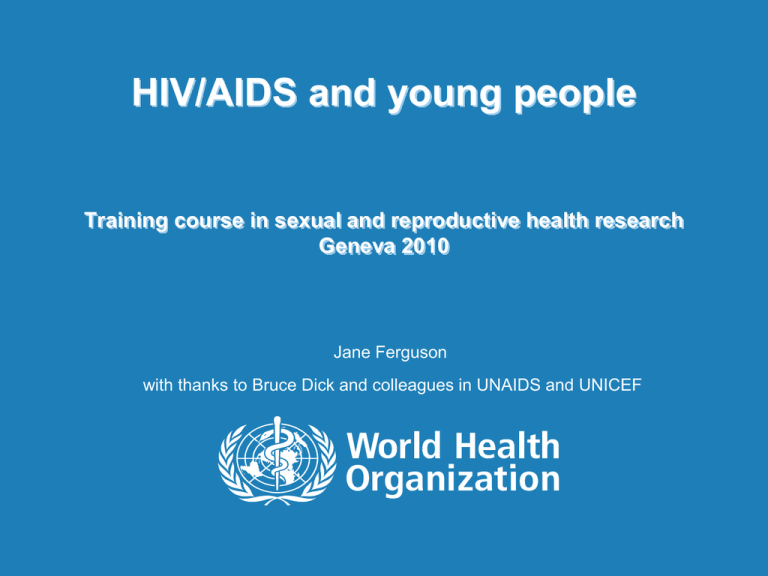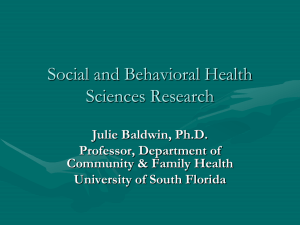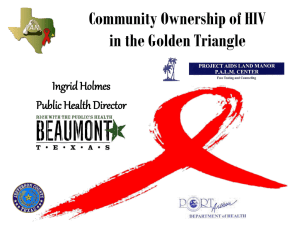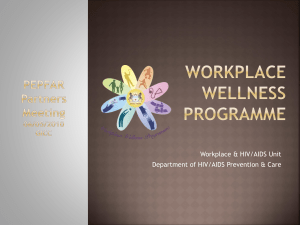
HIV/AIDS and young people
Training course in sexual and reproductive health research
Geneva 2010
Jane Ferguson
with thanks to Bruce Dick and colleagues in UNAIDS and UNICEF
Session objectives
To understand the reasons why it is important to focus on HIV in
young people
To have an overview of scope of the HIV epidemic in young
people
To have an overview of the special needs of adolescents living
with HIV (ALHIV)
To have an overview of the responses to HIV/YP: achievements
and challenges
To be aware of some key international resources available
2
Why a focus on young people and HIV/AIDS:
public health arguments
An opportunity to slow the epidemic because young people contribute significantly each year to
new infections globally (900,000 new infections among young people in 2008).
Most infections, globally, are transmitted sexually and sexual behaviour is initiated and modelled
during adolescence.
Young people are important allies for changing social norms and are leading the prevention
revolution by choosing to have sex later, having fewer partners and increasing their use of
condoms. New infections among young people have declined by more than 25% in 7 countries.(1)
With the roll out of treatment and improved care of children living with HIV, there will be more
adolescents living with HIV. They have specific needs and it is critical to improve guidance,
treatment, care and support for prevention.
In concentrated epidemics, young people constitute a larger proportion of "most-at-risk
populations" (i.e. people who inject drugs, people who sell sex and men who have sex with men).(2)
1.International group on analysis of trends in HIV prevalence and behaviours in young people in countries most affected by HIV, 'Trends in HIV prevalence and
sexual behaviour among young people 15-24 years in countries most affected by HIV', in press
2.Interagency working group et al, Young people most at risk of HIV. Family Health International, 2010
3
Why a focus on young people and HIV/AIDS:
political arguments
The Millennium Development Goal (MDG) 6 includes the following targets:
Halt and begin to reverse, by 2015, the spread of HIV/AIDS
Indicators relevant to young people:
6.1 HIV prevalence among population aged 15-24 years
6.3 Proportion of population aged 15-24 years with comprehensive correct knowledge of HIV/AIDS
Achieve, by 2010, universal access to treatment for HIV/AIDS for all those who need it
2001, United Nations General Assembly Special Session (UNGASS) on
HIV/AIDS includes the following targets:
Reduce HIV prevalence among young people aged 15 to 24 by 25 per cent globally by
2010
Ensure that 90 per cent of young people aged 15 to 24 have the knowledge,
education, life skills and services to protect themselves from HIV by 2005, and 95 per cent of
them by 2010
4
Why a focus on young people and HIV/AIDS: human rights arguments
from needs and responsibilities to rights and obligations
Adolescents have essential
needs, including those related to
their healthy growth and
development
Meeting these essential needs requires the
acceptance of responsibilities by various
players in society
The recognition of essential needs and the
acceptance of responsibilities leads to the
definition of standards of treatment for
adolescents
Existence of rights places a legal
obligation on the Government
and others to ensure that they are
respected and fulfilled, forming the
basis for accountability
Rights codify such standards adding legal
status. Rights articulate just or equitable
treatment and fairness in decisions
according to standards and codes
established by a legitimate authority
5
Nearly 5 million young people (15 – 24 yrs) are infected globally. Over 900,000
were newly infected in 2008, an estimated 2 500 each day
Source: UNAIDS, 2009 AIDS Epidemic Update
♂
Sub-Saharan
Africa
(4.0 Million)
31%
2.8 million in 10 countries
More than 1 in every 20 young
people infected with HIV in 9
countries
♀
69%
♂
Latin America &
the Caribbean
(300,000)
57%
South Asia
(210,000)
East Asia &
Pacific
(210,000)
♀
44%
57%
43%
♂ ♀
CEE/CIS
(70,000)
♀
♂
41%
59%
52% 48%
Middle East &
♀
North ♂
Africa
(89,000)
49%
51%
6
♂ ♀
In the last three years, young people have accounted
for more than one third of all new infections
Source: UNAIDS, 2006, 2008, 2009
7
Gender disparities in prevalence reflect inequalities in social and
economic opportunities and access to services
Distribution of HIV infections between young males and females, aged 15 – 24 yrs in
countries with highest gender disparity
8
Source: UNAIDS, Dec 2008 with additional analysis by UNICEF
Percent of female sex workers who are
adolescents or under the age of 25 years
A significant percentage of most-at-risk
populations are under 25 years
AIDS in Asia: Face the Facts – WAP Report 2004
http://www.mapnetwork.org/docs/MAP_AIDSinAsia2004.pdf
9
There are different types of HIV epidemics
Low-level scenarios are those with HIV prevalence levels of below
1% and where HIV has not spread to significant levels within any
subpopulation group.
Concentrated scenarios are those where HIV prevalence is high in
one or more sub-populations such as men who have sex with men,
injecting drug users or sex workers and their clients, but the virus is
not circulating in the general population.
Generalized scenarios are those where HIV prevalence is between
1–15% in pregnant women attending antenatal clinics, indicating that
HIV prevalence is present among the general population at sufficient
levels to enable sexual networking to drive the epidemic.
Hyper-endemic scenarios refer to those areas where HIV prevalence
exceeds 15% in the adult population, driven through extensive
heterosexual multiple concurrent partner relations with low and
inconsistent condom use and low male circumcision.
10
The scenarios across the world
(Global HIV prevalence 2007)
Hyperendemic
Generalized
Concentrated
11
Young people are not all the same,
within and between countries
Their needs and
circumstances vary due to
their age, sex, marital status,
parental and financial
support, educational status,
employment status, ruralurban, etc.
Social context influences
everything
All adolescents are
vulnerable, but some are
more vulnerable than others
12
Differences between the general
population of adolescents, vulnerable
adolescents, and most at risk adolescents
(MARA)
Male and female adolescents who are engaged in
behaviours that put them at high risk of HIV
(e.g. injecting drugs with shared needles/syringes,
having unprotected sex with many partners)
As for the general population and Especially
adolescents, plus:
Interventions to reduce harm and change behaviour
to decrease risk
Especially Vulnerable
MARAs
Adolescents
General Population of
Adolescents
Adolescents with individual characteristics
or environmental factors that make it more
likely that they will adopt high risk behaviours
As for the general population, plus:
Structural interventions (e.g. poverty reduction)
Individual interventions to mitigate
vulnerability (e.g. counseling and protection)
The general population of
adolescents …
some are vulnerable
and some will adopt
behaviours that
will put them at high risk
of HIV
Interventions: information,
13 services
skills,
Know your epidemic in order to
tailor your response
Absent or insufficient data are major constraints in responding appropriately to
young people’s needs for HIV information and services. Strategic information
on the epidemic and its social drivers should inform and support programmatic
and policy decision-making. Information is therefore needed on the following:
Where, among whom and why are HIV infections occurring now?
Who are the young people with highest HIV prevalence rates (by age, sex
and diversity)? What are their risk behaviours, and where are the settings in
which these behaviours occur?
How are infections moving among young people?
HIV may move through a “network” of exposures (i.e. from young sex
workers to clients to another sex worker who may transmit HIV to his or her
regular partners).
What are the 'drivers' of the epidemic among young people?
What are the cultural, economic, social and political factors that make young
people vulnerable or force them to adopt high-risk behaviours?
14
What needs to be done to prevent HIV?
Combination prevention interventions
– Those that change individual
behaviours (e.g. sexuality education,
behaviour change communication (BCC))
– Those that ensure access to
biomedical tools and technologies
that reduce the likelihood of risk
behaviour leading to HIV
transmission (condoms, needle
exchange, micro-bicides, male circumcision,
HIV testing & counselling (HTC), antiretroviral (ARV) medication)
– Those that alter social and cultural
norms or physical environments to
facilitate risk reduction and
maximize the reach and impact of
prevention services (e.g. policies to
ensure access to interventions, to set age at
marriage, to reduce stigma & discrimination,
to prevent & punish acts of sexual violence;
to change social norms, for example agedisparate sex; to alter gender norms;
conditional cash transfers to encourage
completion of schooling)
15
What are some particular considerations for young people?
Behavioural interventions
– Developing capacity to think and understand – importance of
age specificity
Biomedical tools/technologies
– Often barriers to service delivery – importance of improving
service access and quality (i.e. youth-friendly health services)
Societal interventions
– Policies may not deal specifically with young people, social
norms and values may make young people particularly
vulnerable
16
Consensus around key behavioural outcomes
for young people
Delay sexual
debut
Reducing age
disparate sexual
partnerships
Reduce numbers
of sexual partners
– particularly
concurrent partners
Increase consistent
condom use
Increase coverage
and utilization
of testing &
counselling services
Increasing
knowledge of
HIV sero status
Critical to focus on
content, quality
intensity of prevention
inputs
Increasing
male circumcision
(where HIV prevalence is high
and 17
MC rates are low )
Although there has been improvement in comprehensive correct knowledge among young
people, STILL only 30 per cent of young men and 19 per cent of young women have
accurate and comprehensive knowledge of HIV.
Most countries are far from reaching the UNGASS 2010 targets
Developing countries with 10 or more percentage point increase in the percentage of young women and men aged 15-24
Source: UNICEF global databases, 2010 (MICS, DHS and other national surveys, 2003-2008)
with comprehensive correct knowledge of HIV
Young women aged 15-24
Young men aged 15-24
Global 2010 target (95%)
31
Namibia 2000-06/07
33
Trinidad and Tobago 2000-06
54
23
Rwanda 2000-05
36
50
Cambodia 2000-05
37
50
25
19
Haiti 2000-05/06
15
Cameroon 2000-06
16
Jordan 2002-07
17
India 2001-05/06
36
14
Benin 2001-06
39
35
34
21
Nigeria 2003-08
32
Uzbekistan 2000-05 3
5
40
39
26
Tanzania 1999-07/08‡
28
Haiti 2000-05/06
41
15
Central African Republic 2000-06
42
41
18
Dominican Republic 1999-2007
7
29
Tanzania 1999-07/08‡
42
27
Suriname 2000-06
Armenia 2000-05
54
44
Moldova 2000-08*
Gambia 2000-06
31
0
Indonesia 2002/03-2007*
23
17
0
33
15
20
40
3 13
0
62
20
Rwanda 2000-05
44
11
Sao Tome and Principe 2000-06
41
Namibia 2000-06/07
51
Guyana 2000-06
Viet Nam 2000-06
Global 2010 target (95%)
65
10
20
30
40
50
60
70
80
90
100
18
60
80
100
An example of changing social values and norms
19
One group of adolescents that is particularly vulnerable
are young people living with HIV
2
20
What makes adolescence different from
childhood and adulthood?
A period of rapid development and
change:
– Physical: their bodies and brains
– Psychological: how they think about
themselves and others; how they deal
with and express their emotions
– Social: their relationships and roles,
expectations (of themselves and by
others), opportunities, moving towards
family formation, economic security, and
citizenship
21
How are these differences important for care, treatment,
support and prevention of HIV infection?
Because these changes have implications for:
– How adolescents understand and act on information
– What influences them, what they are concerned about
– How they think about the future and make decisions
Because adolescence is a period of:
– Experimentation, risk taking and first-time experiences
– A key period of sexual development: relationships, sexual debut,
sexual preference …
22
What needs to be done for young people
living with HIV/AIDS?
– Access to HIV Testing &
Counselling
– Care and psychosocial support,
including for those not yet requiring
treatment
– Access to service providers who are
sensitive to adolescents' needs
– Disclosure of HIV status (both to
adolescents and to those who can
support them)
– Adherence to treatment
– Continuum of care i.e. transition
from paediatric to adult care
– Dealing with stigma & discrimination
– Preventing behaviours which put
them and partners at risk of HIV
infection
– Support to consider their future
reproductive health
23
The needs of adolescents living with HIV differ depending on
the transmission period (perinatal or adolescence)
24
How much attention are young people receiving in
HIV/AIDS activities in countries?
Of 87 National HIV/AIDS Strategic Plans available for
review, 55 (63%) had specified objectives,
strategies/activities, targets and/or indicators related to
HIV prevention among young people. Those Strategic
Plans from countries in Asia/Pacific, Eastern Europe and
Central Asia were most likely to include content specific to
young people.
Source: Interagency Task Team on HIV/AIDS and young people, draft document 2010
25
Review of proposals submitted to the
Global Fund on HIV, TB and Malaria
(Hildy Fong, CAH/WHO, 2007)
1. Providing
Information
and Life Skills
(47%)
Increasing # teachers trained in HIV/AIDS
(Argentina), Radio and TV campaigns
(Equatorial Guinea), Producing trainer
guides and , student materials (Benin),
Developing IEC materials (China)
2. Planning
and Policy
(14%)
Repackaging data to facilitate planning and
advocacy (Zanzibar), Preliminary surveys
to determine baselines (Cameroon),
Gathering info for policy building activities
(Thailand)
3. Enhancing
Community
Values (12%)
Building Anti-AIDS clubs, Creating youth
friendly spaces out of school (Belize),
Training peer educators (Cote d’Ivoire)
4. Decreasing
Vulnerability
(10%)
Targeting young IDU’s (Estonia,
Indonesia), Target young women
(Lesotho), Military Youth (Eritrea, E
Europe), street youth (Pakistan)
LEVELS OF YOUTH ACTIVITY IN GFATM GRANTS
8 World Regions, Rounds 1-6
(N = 178 proposals, including unsigned proposals)
4%
43%
5. Improving
Health
Services and
Counselling
(9%)
Establishing VCT sites (Armenia), Training
health professionals for youth friendly
services (Mozambique)
6. Condoms
and Other
Health
Commodities
(8%)
Establishing condom sale outlets (Sierra
Leone), Condom vending machines
(Mongolia), Condom Promotion Activities
(El Salvador)
7. Other (only
2)
Providing health counseling through the
internet, “Reward Trips”
53%
Proposals w ith major youth activity
Proposals w ith moderate youth activity
Proposals w ith minor youth activity
26
Conclusions
Young people remain at the centre of the HIV pandemic
Despite important progress, national HIV/AIDS programmes have
not given sufficient attention to young people and in general we are
far from achieving the 2010 goals
There is a good evidence base for interventions to prevent HIV
among young people, including behavioural, biological and societal
interventions
Groups of young people who require special attention include
adolescent girls, most-at-risk adolescents and adolescents living
with HIV
27
Useful WEB sites
Findings from Demographic and Health Surveys from more than 30 countries worldwide
about youth aged 15-24 http://www.measuredhs.com/topics/Youth/start.cfm
Advocating for Effective Youth HIV Prevention Interventions http://who.tigweb.org/
Resources on youth reproductive health and HIV/AIDS
http://info.k4health.org/youthwg/pubs/IYWGpubs.shtml#InfoNet
www.unesco.org/en/aids
http://www.unicef.org/aids/index_documents.html#Prevention
http://www.unfpa.org/public/iattyp/
www.who.int/child-adolescent-health/
www.unaids.org/en/knowledge_centre
28
Assignment
Empowering young people to protect themselves from HIV represents
one of UNAIDS’ ten priority areas, with the overall goal of a 30%
reduction in new HIV infections by 2015 (c.f. UNAIDS young people
document).
Using the resource materials to assist you in addition to the
knowledge of your country:
Identify the groups of young people in your country who should be
targeted with HIV interventions.
Describe briefly the factors (the 'drivers') which make them
vulnerable.
List the interventions most important (for each group) which would
contribute to achieving the UNAIDS goal.
29








